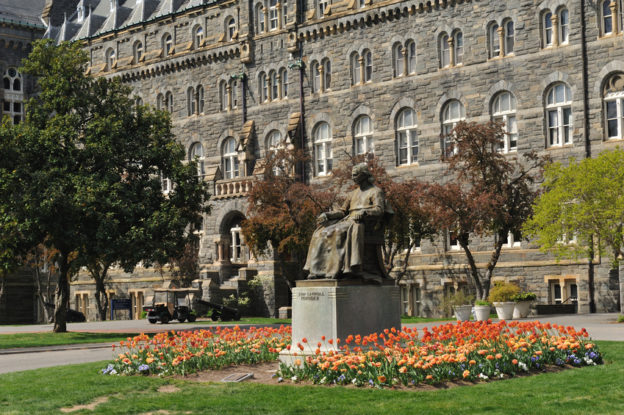As I woke up in the morning and read the first pages of my school’s newspaper, The Hoya, on the 1st of April, 2009, I could only question why I decided to attend an institution in which my racial identity was violently attacked. This was one of the multitude of experiences I faced at Georgetown.
When Jena 6 became a national story, the same newspaper prioritized writing about a protest of an alcohol policy rather than Georgetown’s NAACP 8-hour vigil that drew in over 100 people; Jena 6 was featured in the back of the newspaper. Finally, there was an occasion in which a satirical newspaper, named the Georgetown Heckler, wrote a story and the front page featured a ceremony of the Ku Klux Klan.
Currently, I am getting my MPH at Emory University, and plethora of people have asked me about my experience at Georgetown. I always struggle and still say that Georgetown made me grow as a person, but the racial violence I experienced there was relentless. The newspaper stories only provide a glimpse and described what was going on at Georgetown; however, going through this toxic racism while studying made my experience very challenging.
As a person of color in a predominately white institution, I faced much discrimination, and this experience was not unique to me. Some people questioned my intelligence and believed that I occupied someone else’s space that deserved to be at Georgetown. I was asked a multitude of times about the “team,” which was an underlying question that assumed that I got in because of a sports scholarship. I was called the “N” word, asked why Black people liked to listen to rap, and became the spokesperson of the Black community when I was the only Black person in a class.
Many times, I felt alone and depressed; however, I was grateful that I attended an institution in which the students protested and did not let these issues go away. The year before The Hoya’s April Fools article, the LGBTQ community had fought for justice and created a working group since LGBTQ persons were experiencing physical and verbal harassment. Georgetown became the first Jesuit institution to have an LGBTQ resource center. I was the freshman historian at the time, and I was fortunate to document and be part of the Out for Change campaign that fought for acceptance and inclusion on campus.
In each of the examples of the racial violence published on campus, the students addressed these issues without cowardice. When the Jena 6 article was published in 2007 and placed with minimal importance, the students protested, chanted, and called on The Hoya to become more inclusive in their news coverage. The following year, I became Secretary of Diversity in the Georgetown Student Association (GUSA) when the April Fools and Georgetown Heckler stories were published; thus, I was in the forefront of most of these discussions. Georgetown students created a town hall after the April fools issue was published, there we determined that we were going to participate in civil disobedience and do a sit-in. Moreover, the students vowed to fight for sanctions to occur. The staff of The Hoya for years had been fighting for the newspaper to become independent; however, that did not happen due to their gaffe. Every subsequent year after the article, the staff were required to participate diversity and sensitivity training. When the Georgetown Heckler published the article with the KKK, the students formed another town-hall and we had administrators even come to the event. An African-American faculty was visibly distraught, and commented that the image of the article was triggering because he had friends who were murdered, lynched, and harassed by the KKK.
As you can see, my experience at Georgetown was very challenging, and I could probably write more, but this post would become a long chapter in a book. However, now as an alumnus, reading about Georgetown’s new policy to actively engage as well as to structurally change its campus culture to become more inclusive, makes me feel very encouraged and excited.
Since I graduated in 2012, I cannot speak on the current campus culture at Georgetown anymore. Yet, it was only last year that a Georgetown board decided to amend the curriculum to include a diversity requirement, something we had been fighting for years.
WATCH: GEORGETOWN AMENDS FOR SALE OF SLAVES
I’m very grateful to see it’s setting a precedent for other institutions. Offering preferential status in admissions for students who are descendants of slaves is a necessary step that other institutions that also profited from slaves should do. By Georgetown University officials changing the name of a building to disavow the college presidents in the 1838 sale to honor a slave, it creates a huge precedent. It also sets a tone for other institutions who are battling to preserve the history of buildings’ names to take action, and to not be afraid of changing their own campuses.
Finally, Georgetown’s board of directors’ recent approval of a Department of African American Studies is remarkable The board also aims to increase faculty who are of color. This commitment to racial justice is a major shift from my experience at Georgetown to the present. Yes, I had a very challenging time at Georgetown. I wrestled with my identity and at times questioned why I attended this institution. However, I’m grateful that Georgetown is actively recognizing their mistakes.
Within a few years, I am hoping that Black students can feel embraced, accepted, and not isolated like in my experience. Now, I can definitely mention to my classmates that although Being Black at Georgetown was a very trying experience, Georgetown is making radical changes and setting the tone that many other institutions are not doing.








